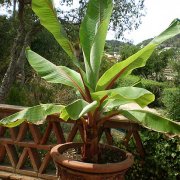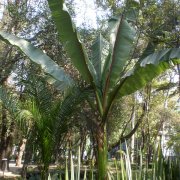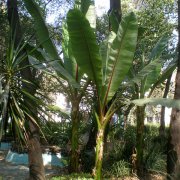Care of the rhizomatous plant Ensete ventricosum or False banana |
|
The genus Ensete, family Musaceae, includes 7 species of perennial plants native to Asia and Africa. Some species are: Ensete ventricosum, Ensete superbum, Ensete glaucum. Common names: False banana, Enset, Ensete, Ethiopian banana, Abyssinian banana, Pseudo-banana. Scientific synonym: Musa ensete. This species is native to Ethiopia. They are rhizomatous herbaceous plants of arboreal bearing and thick trunk that reach 14 meters (45.93 feet) in height. The long, elegant leaves are bright green with a reddish midrib. They flower only once (after the plant dies) with a hanging panicle with pink bracts. The fruits are not edible but the roots are. False banana is used as isolated specimens, in small groups and in large pots as indoor, greenhouse and patio and terrace plants. Ensete ventricosum needs exposure to full sun or very light shade and high temperatures. In winter they need a rest at 10-15 ºC (50-59 ºF). It does not resist frost. The soil can be a mixture, in equal parts, of leaf mulch, normal garden soil, and heather soil. Transplantation or planting is done in spring or autumn. Water frequently with lime-free water (2 times a week) but without flooding, enough so that the substrate is damp. It is important that the humidity is high: spray the leaves from time to time with water without lime. Fertilize in autumn with manure and mineral fertilizer every 2 weeks in spring and summer. Ensete ventricosum is a plant that can be attacked by aphids, mealybugs, mites and worms in the roots. False banana is propagated by division and from seed in spring. |
Images of the rhizomatous plant Ensete ventricosum or False banana |
Find plants
Ensete ventricosum or False banana | Care and Growing
© 2025 FavThemes


